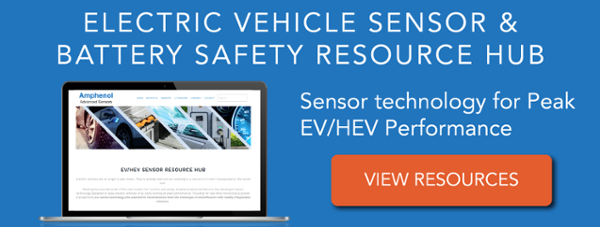EV Trends & Sensor Technology: Synchronous Growth

Electric cars are getting all the attention in the transportation industry.
This comes as no surprise. There’s been a race by auto manufacturers to bring electric cars and trucks to the masses in recent years. It’s only become more competitive as consumers are now more environmentally conscious and governments are taking legislative steps to reduce carbon emissions.
EV trends that have dominated the last several years aren’t expected to let up in any sense this year. In fact, the EV market is only expected to grow. In addition, cars and trucks aren’t the only modes of transportation expected to convert from fossil fuels to a greener source. Name a type of vehicle, and chances are there’s already an electric-powered alternative.
With new technology comes more new technology.
As the electric vehicle market grows, the electric vehicle sensor market will, too. The reason is simple: Just like vehicles with an internal combustion engine, EVs need high-performing and accurate sensor technology to ensure performance and safety.
EV Trends to Keep an Eye on
The biggest electric vehicle trend we can expect this year are the electric vehicles themselves. And by that, we mean the EV market is anticipated to continue its ongoing trend of gaining more market share. In simpler terms, EV adoption isn't expected to slow down at all.
Consider: in 2018, just 2.1 million EVs were sold worldwide. This year,sales are expected to nearly triple to 6 million units sold and that number could potentially increase even more. In fact, this year may be the first year that EVs and gasoline-powered cars may sell for near identical prices.
We can expect electric cars with improved range and performance. Electric vehicles are no longer just limited to basic, small commuter cars. We’ll begin to see more high-performance EVs with increased range and power capabilities, making them viable options for luxury car buyers as well.
On the charging side of things, we can look forward to an EV trend of better charging infrastructure and technology. More EV charging stations will be added throughout the US and abroad, which is important for encouraging EV adoption.
Finally, government incentives will continue to drive consumer interest in electric vehicles this year. As awareness around global warming increases and emissions standards become stricter, governments from all over the world -- most notably, China, India, and the EU, have implemented various financial incentives to encourage consumers to buy electric vehicles instead of gas-powered cars.
Electric Vehicle Industry Trends: Growth Beyond the Sedan & Pickup
Though electric cars and electric trucks are front and center in the “electrification revolution,” they’re only two components of the overall sea change in transportation and EV trends.
Almost every vehicle type is slated for electrification. Many financial reports and electric vehicle industry trends show this shift is well underway.
Alongside cars and pickups, other electrified vehicles you’ll see more of include:
- Buses: From those transporting school children to those supporting urban commutes, fully electric bus fleets are on the horizon. Billions of dollars are being eyed by federal lawmakers to fund the conversion of transportation systems away from fossil fuels.
- Semis: One of the largest vehicles on the road presents one of the most impactful paths to reducing emissions. The electric semi market is expected to more than double by 2026.
- ATV & Utility Vehicles: Among the smallest vehicles slated for electrification the ATV and utility vehicle market is projected to grow from 2020’s $468 million to $4.3 billion by 2030.
- Aircraft: The skies are poised to be greener with the conversion to electric-powered airplanes. Many major airlines are planning to follow the automotive industry by eliminating fossil-fuel use from their fleets.
- Boats & Ships: Already valued at $5 billion, the electric boat and ship market is slated to reach $10 billion by 2026.
Electric Vehicle Sensors: The Key to Continued Industry Growth
As the global fleet of vehicles transitions away from fossil fuels and into electricity, the role of sensor technology -- especially in battery management -- will become critical.
Just like the fueling system of an internal combustion engine, an EV’s battery systems need constant monitoring to ensure optimal performance and safety.
Electric vehicle sensors for batteries are more than an updated version of a gas gauge. They’re sophisticated tools for measuring key performance elements, such as:
- Thermal management
- Energy management
- Battery health
- Humidity control
Thermal Management
One of the most detrimental environments for an EV’s battery is excessive heat. If left uncontrolled, thermal runaway may occur, an event during which a battery cell degrades and releases flammable gasses. Without intervention, the battery thermal event can even trigger a chain reaction through the entire battery pack, with more cells undergoing thermal runaway until the pack is damaged beyond recovery.
In addition, batteries, motors, and inverters have a temperature window where the performance is high, but outside that window, performance degrades. For batteries, that optimal range is approximately 15C to 35C. At colder temperatures, the internal kinetics of the cell drive lower charge and discharge rates, reducing available pack power, and at higher temperatures, battery cells can degrade quickly, which requires that the system be controlled by heat exchangers that can both extract heat from the cells or add heat as necessary, and all require accurate temperature sensor feedback.
Humidity
Next to overheating, humidity is an EV battery design’s worst enemy. With humidity comes condensation.
In an EV battery pack, condensation means an increased risk for a short circuit. An electrical short in an EV is enough to trigger thermal runaway or other malfunctions. Monitoring the battery pack for condensation buildup over long life spans has become more of a concern, as the water from humidity in the form of condensate and the potential for small leaks in the packs cooling system can contribute to corrosion and electrical shorts, which can not only damage the pack, but can hydrolyze and form dangerous levels of hydrogen gas.
Energy Management
To run an electric vehicle of any size or type requires a lot of energy. Thus, monitoring its energy intake during charging and consumption during use is key to consistent performance.
Fast charging, one of the major requirements consumers are looking for in EVs, requires constant monitoring, as in rare instances, quickly charging a lithium-ion battery can cause overheating. Sensors designed to manage a variety of systems -- from a vehicle’s HVAC to even a regenerative braking system -- are key to helping the owner get the most from their vehicle without worry. A typical example includes monitoring the temperature of the vehicle’s charging connections. Higher than expected temperatures in the high voltage connections indicate that a charging handle or plug is worn out and requires replacement.
4. Battery Health
Both short- and long-term EV battery performance are perceived barriers to many potential adopters -- how can they trust a vehicle won’t run out of juice and leave them stranded?
Understanding an EV’s overall battery health serves three purposes for the vehicle owner:
- Knowing how far the vehicle can travel on its current charge
- Evaluating its usefulness over the life of the vehicle
- Identifying small performance issues before they become bigger
Sensors play a key role in providing accurate measurements of State of Charge (how much farther you can travel) and State of Health (how much life is left in the battery pack).
Can Sensors Keep up With EV Industry Trends?
With the electric vehicle industry in the beginning stages of unprecedented growth, whatever EV trends are on deck, sensor technology is set to follow suit.
In part, the long-term future of electrified transportation depends on the availability of dependable and accurate sensors. While there’s still some consumer reluctance to accept the latest evolution in transportation, today’s electric vehicle sensors can ensure a car, bus, or even plane ride is a much quieter and higher quality experience than today’s thermal engine technology.
In the Market for Electric Vehicle Sensors?
Book time with one of our engineers to discuss your needs!





